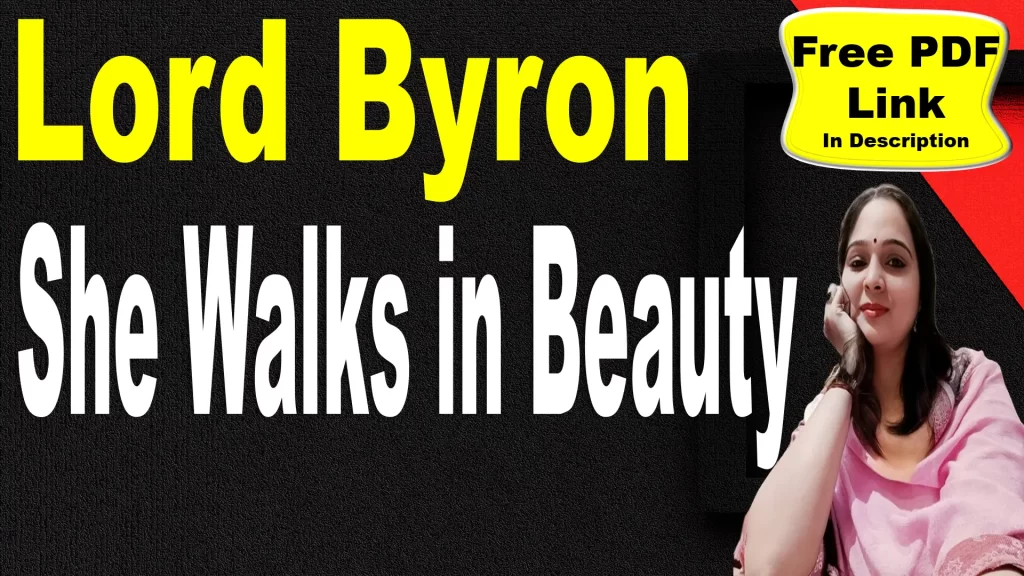
She Walks in Beauty Questions and Answers
Very Short Answer Questions
Who wrote the poem She Walks in Beauty?
Lord Byron (George Gordon Byron).
When was She Walks in Beauty written?
In 1814.
When was the poem published?
In 1815, in Hebrew Melodies.
What inspired Byron to write She Walks in Beauty?
The beauty of Anne Beatrix Wilmot, his cousin’s wife.
What is the main theme of the poem?
The harmony of inner and outer beauty.
What is the rhyme scheme of the poem?
ABABAB.
What poetic form does the poem follow?
It consists of three six-line stanzas (sestets).
What type of meter is used in the poem?
Iambic tetrameter.
Which two contrasting elements does Byron use to describe beauty?
Light and dark.
What does Byron compare the woman’s beauty to?
A cloudless, starry night.
What does the phrase “nameless grace” mean in the poem?
An indescribable elegance and charm.
What does Byron say about the woman’s thoughts?
They are serene and pure.
What feature of the woman does Byron emphasize in the second stanza?
Her dark, flowing hair (raven tress).
What do the woman’s smiles and glow represent?
A life spent in goodness and kindness.
What literary device is used in “She walks in beauty, like the night”?
Simile.
What does the phrase “a heart whose love is innocent” suggest?
She is pure-hearted and virtuous.
What is the tone of the poem?
Admiring, calm, and reverent.
What does the poet imply about the woman’s mind?
It is at peace with the world.
How does Byron personify “heaven” in the first stanza?
He says it denies gaudy (excessive) brightness to the day.
What does the poem ultimately celebrate?
The perfect balance of physical beauty and inner goodness.
Short Answer Questions
What is the main idea of She Walks in Beauty?
The poem praises a woman’s beauty, emphasizing that it is a perfect balance of light and dark, external charm and inner goodness. Byron admires her grace, innocence, and peaceful nature, suggesting that true beauty comes from both appearance and character.
How does Byron describe the woman’s beauty in the first stanza?
He compares her beauty to a cloudless, starry night, highlighting the harmony of darkness and brightness. This contrast suggests that her beauty is not overpowering like daylight but soft and mysterious. The phrase “tender light” implies that her beauty is both gentle and divine.
Why does Byron say, “One shade the more, one ray the less” in the second stanza?
Byron suggests that her beauty is so perfectly balanced that even a small change in light or shade could lessen her charm. This line emphasizes the idea that true beauty is a delicate and natural harmony. It also reflects the poem’s recurring theme of contrast and balance.
What role does light and darkness play in the poem?
Light and dark symbolize external beauty and inner virtue. Byron describes the woman as a combination of both, making her beauty unique and harmonious. The contrast reflects the Romantic belief that true beauty is a balance of opposing elements in nature.
What does Byron say about the woman’s thoughts and expressions?
He describes her thoughts as serenely sweet, meaning she has a peaceful and pure mind. Her expressions reflect her inner goodness, and her face glows softly, symbolizing her kindness and innocence. This suggests that her beauty comes from both her appearance and her soul.
What qualities of the woman does Byron admire in the last stanza?
Byron admires her soft, calm expressions, which show her inner peace and virtue. He notes that her smile and glowing face reflect a life lived with kindness and goodness. Her mind is at peace with the world, and her heart is pure and innocent, making her beauty spiritual rather than just physical.
What is the tone of the poem, and how does it affect the reader?
The poem has a calm, admiring, and reverent tone. Byron’s use of soft imagery, contrasts, and smooth rhythm creates a musical and gentle effect. This tone makes the reader feel a sense of peace, admiration, and appreciation for natural beauty.
How does Byron’s use of poetic devices enhance the poem?
Byron uses simile (“She walks in beauty, like the night”) to compare her beauty to a starry night, emphasizing its harmony. Imagery (“raven tress,” “tints that glow”) makes her appearance vivid, while contrast (“dark and bright”) highlights the balance of light and shadow. These devices create a lyrical and elegant effect, reinforcing the poem’s theme.
Why is the poem considered an example of Romantic poetry?
The poem reflects Romantic ideals by focusing on emotion, nature, beauty, and individual experience. Byron compares beauty to natural elements (the night sky), emphasizing the power of emotions and the connection between inner goodness and outer beauty. The admiration of purity and simplicity is also a key Romantic theme.
What message does Byron convey about true beauty?
Byron suggests that true beauty is not just physical but a reflection of inner goodness and harmony. The woman’s beauty is perfect because it combines contrasts (light and dark, appearance and character). Her innocence, virtue, and peaceful mind make her beauty timeless and divine, rather than just superficial.





